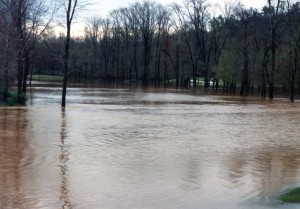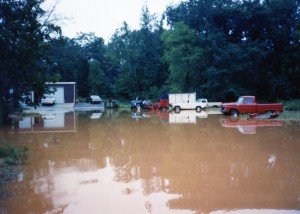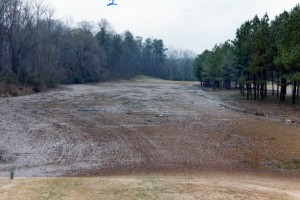After The Flood
Here at the GCS Rest Home and Asylum, I like to gaze out the bay window in my private room while I listen to the other inmates residents debate various topics down in the mess hall. I dont really have a bay window, just a soft padded wall, but I like to pretend because it irritates the nurses. (Glass is verboten in the high-risk lockdown wing of the GCSRH&A.)
Todays debate concerned the golf course problem most likely to land a GCS in the Home. I eavesdropped on the discussion for a while, but had no desire to jump into the argument, because I knew exactly how a GCS ends up here and it isnt army worms, impossible green chairs, spike marks, poa, stimps, foxes digging holes the size of a hogs head in #17 green or clubhouse food. (Although that last one ranks highthe employee meals at Brokenfinger CC were capable of killing a goat, and I know that because we employed a goat as our food taster, may he rest in peace.)
 Its the floods that will get you.
Its the floods that will get you.
Due to some sort of Karmic punishment, I served time on four straight golf courses given to flooding. By flooding, I dont mean a once-in-a-blue-moon out of the creek banks annoyance, I mean six-foot deep biblical floods that drown 13 holes, rip up cart paths like they were hit with a giant cheese grater and close the golf course for three months.
I spent 12 years at Sugar Creek below Atlanta, a course better suited to bass tournaments than golf tournaments.
I witnessed floods that left mountains of silt three feet deep and 200 yards in length, right smack in the middle of the landing areas. We measured floods using the scientific notation Porta-Potties, a standard indicator of severity that quickly told upper management in the municipality how long a recovery period to expect.
A One Porta-Potty Flood usually meant somewhere upstream in Atlanta had received a 1 rain and we flooded enough to watch our front side restroom facility sail off down the South River.
A Two Porta-Potty Flood was more serious; in a 2PP Flood, our back nine facility headed south and was usually found, in pieces, smashed against a low bridge or wrapped around a tree somewhere between us and Lake Jackson.
A 3PP Flood meant other peoples Porta-Potties had become involved. (We rarely witnessed a 3PP, because we normally evacuated the area during a 2PP.)

I do recall a 3PP, during a deluge that occurred on the same day we were being inspected by a naive golf management company tricked into leasing Sugar Creek. Cowering on the only high ground available to usthe clubhouse second floorI was asked by the management company rep if flooding was a common problem. At that very moment, a third Porta-Potty floated by, navigating the brown water rapids like Burt Reynolds in Deliverance, followed by somebodys 300 gallon spray tank, several hundred tires, logs, stumps, basketballs and various components of what was once an above-ground swimming pool.
Having been warned by the Deputy Director of Parks not to say anything that might kill the lease deal, I answered in the positive. Well, sir, this is an uncommonly powerful flood, being a 3PP and all . . . most of our floods are just 1PPs. In fact, we had 12 floods in 1994 and all but three were 1PPs . . . of course, it probably wont matter how this one rates, cause weve screwed around here so long, its likely were all gonna die. Look, the crew is trapped at the shop again.
I got reprimanded for that one. I put my letter of official ass-chewing in the cabinet with the other 600 letters.
I dont understand why the DDP got so upset with me. I never once mentioned the 3 billion weed seeds that come in with every flood or the fact that a 1" rain typically closed #2 and #12 for 90 days.
After years of dealing with flooded golf courses, I experienced three profound revelations. First, these courses were designed by nincompoops, buffoons and numbskulls.
Second, I hate that warning that always pops up whenever architectural adjustments become necessaryyou know, the You must hire an architect, dont let the GCS do it! On this particular course, the muni Powers-That-Be resisted my suggestions and blew about $30k of the taxpayers money hiring an experienced golf architect firmthe aforementioned NBNto submit a plan to stop the flooding. On the day of their presentation, NBN put forth a grand plan, with berms to stop the flooding, bigger bridges to increase the water flow and bigger drains to dry the fairways quicker.
Their plan was rejected, but not because berms only make the problem worse downstream, as in the larger scale example of the Mississippi River berms. Their plan was rejected, but not because the bridges were pork deals or the drains would be four feet under water when they were needed most . . . they were rejected because the highly trained NBN architects had the South River running in the opposite direction and I don't remember exactly how they planned to accomplish that.
My third revelation involved voices in my head that told me how to deal realistically with floods. You do not attempt to defeat the flood, you work with the flood.
How do you work with the flood?
I didnt attack the problem with a drafting table, I stood in the rain for hours, watching how the water moved across the land. When the solution hit me, I drew up a basic corrective action for one hole and showed it to the Director of Public Works. A few days later, I was handed an Army Corp of Engineers permit and told to implement my plan on the entire golf course. The plan was not to stop the flooding, as the architects had envisioned by sending water uphill, but to reduce the recovery time from 90 days to less than a week.
 Heres what we did: We widened drainage ditches into marshes and used the dirt we gained to raise the landing areas by up to three feet. We removed all ditches that entered the river at 90 degrees and swept them back at angles of 45 degrees, running parallel to the river. This allowed flood water to back up into the marshes, like a time delay mechanism. Cart paths were rerouted to offer the least resistance to the highest speed flood areas and tees were moved to offer the golfer a better chance at hitting the wider, dryer raised landing areas.
Heres what we did: We widened drainage ditches into marshes and used the dirt we gained to raise the landing areas by up to three feet. We removed all ditches that entered the river at 90 degrees and swept them back at angles of 45 degrees, running parallel to the river. This allowed flood water to back up into the marshes, like a time delay mechanism. Cart paths were rerouted to offer the least resistance to the highest speed flood areas and tees were moved to offer the golfer a better chance at hitting the wider, dryer raised landing areas.
In the accompanying before photo, #2 is shown after a 1" rain, covered with silt and mud. In the after shot, #2 could withstand a 3" rain event/flood and be playable the next day.
I know what you're thinking. If this idiot was successful at Sugar Creek--rounds went from 9k to 30k - how did he end up in solitary at the GCS Rest Home and Asylum?
After we spent eight months working dark to dark, seven days a week, I was a little ill-tempered when the county leased us out to a management company.
If youre concerned you might end up here with me, dont worry. Its not so bad. The food is good, the nurses are hot and, well, just check out the video for yourself.




0 Comments
Recommended Comments
There are no comments to display.